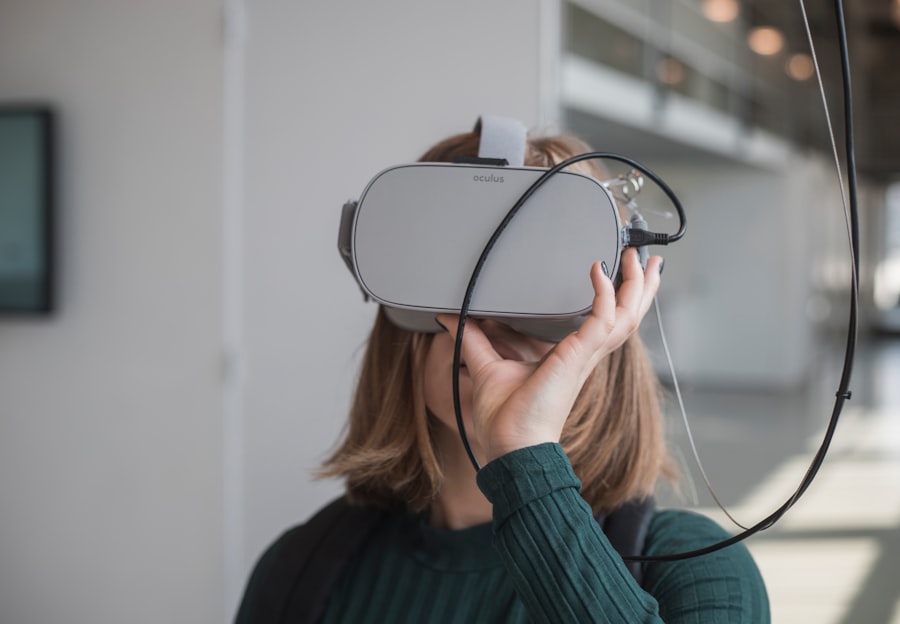The intersection of artificial intelligence (AI) and fashion is a burgeoning field that has begun to reshape the industry in profound ways. As technology continues to evolve, the fashion sector is increasingly leveraging AI to enhance creativity, streamline operations, and improve customer experiences. From design to retail, AI is not merely a tool but a transformative force that is redefining traditional practices.
The integration of AI into fashion is not just about automation; it represents a paradigm shift that allows designers and brands to harness data-driven insights, enabling them to make informed decisions that resonate with consumers on a deeper level. As we delve into the multifaceted applications of AI in fashion, it becomes evident that this technology is revolutionizing how brands operate and engage with their audiences. The potential for AI to analyze vast amounts of data quickly and accurately means that fashion companies can respond to trends and consumer preferences with unprecedented agility.
This capability is particularly crucial in an industry characterized by rapid change and shifting consumer demands. By embracing AI, fashion brands are not only enhancing their operational efficiency but also fostering a more personalized shopping experience that caters to the unique tastes and preferences of individual consumers.
Key Takeaways
- AI is revolutionizing the fashion industry by enhancing design, production, shopping, and sustainability.
- AI is streamlining design and product development processes by analyzing trends and consumer preferences.
- Personalized shopping experiences are being improved through AI-powered recommendation systems and virtual styling tools.
- AI is optimizing supply chain and inventory management by predicting demand and reducing waste.
- Predictive analytics and trend forecasting are being enhanced by AI, enabling brands to stay ahead of market trends.
- AI is being used to promote sustainability and ethical practices in the fashion industry.
- The future of AI in fashion looks promising, with continued advancements in design, production, and sustainability.
AI in Design and Product Development
In the realm of design and product development, AI is proving to be an invaluable ally for fashion designers. By utilizing machine learning algorithms, designers can analyze historical data, consumer feedback, and current trends to inform their creative processes. This data-driven approach allows for the generation of innovative designs that are more likely to resonate with target audiences.
For instance, AI can assist in identifying color palettes, fabric choices, and styles that align with emerging trends, thereby reducing the time spent on trial and error. As a result, designers can focus more on the creative aspects of their work while relying on AI to provide insights that enhance their design decisions. Moreover, AI-powered tools are enabling brands to create virtual prototypes, significantly streamlining the product development process.
These digital representations allow designers to visualize their creations without the need for physical samples, which can be costly and time-consuming. By employing 3D modeling and simulation technologies, brands can experiment with various designs and make adjustments in real-time. This not only accelerates the development cycle but also minimizes waste associated with traditional sampling methods.
As a consequence, the integration of AI into design and product development is fostering a more efficient and sustainable approach to fashion creation.
AI in Personalized Shopping and Styling
The rise of AI in personalized shopping and styling has transformed the way consumers interact with fashion brands. Through sophisticated algorithms and machine learning techniques, retailers can now offer tailored recommendations based on individual preferences, browsing history, and purchase behavior. This level of personalization enhances the shopping experience by making it more relevant and engaging for consumers.
For example, AI-driven platforms can analyze a shopper’s past purchases and suggest complementary items or styles that align with their unique tastes, effectively creating a curated shopping experience that feels bespoke. In addition to personalized recommendations, AI is also revolutionizing virtual styling services. Brands are increasingly utilizing chatbots and virtual assistants powered by AI to provide real-time styling advice to customers.
These digital assistants can answer questions about fit, color coordination, and current trends, offering guidance that was once reserved for in-store stylists. By leveraging natural language processing and image recognition technologies, these AI tools can engage with customers in a conversational manner, making the online shopping experience more interactive and enjoyable. As a result, consumers are empowered to make informed purchasing decisions while feeling supported throughout their shopping journey.
AI in Supply Chain and Inventory Management
The integration of AI into supply chain and inventory management is another area where fashion brands are reaping significant benefits. Traditional supply chain processes often suffer from inefficiencies due to manual oversight and lack of real-time data analysis. However, with the advent of AI technologies, brands can optimize their supply chains by predicting demand patterns, managing inventory levels, and streamlining logistics operations.
Machine learning algorithms can analyze historical sales data alongside external factors such as seasonality and market trends to forecast demand accurately. This predictive capability enables brands to make informed decisions about production quantities and timing, ultimately reducing excess inventory and minimizing waste. Furthermore, AI enhances visibility across the supply chain by providing real-time insights into inventory levels and order statuses.
This transparency allows brands to respond swiftly to fluctuations in demand or disruptions in supply, ensuring that they can meet customer expectations without overextending resources. By automating inventory management processes through AI-driven systems, fashion companies can achieve greater efficiency while freeing up valuable time for employees to focus on strategic initiatives. The result is a more agile supply chain that not only supports business growth but also aligns with sustainability goals by reducing waste and optimizing resource utilization.
AI in Predictive Analytics and Trend Forecasting
Predictive analytics powered by AI is revolutionizing trend forecasting in the fashion industry. Traditionally reliant on intuition and experience, trend forecasting has often been a subjective process fraught with uncertainty. However, with the ability to analyze vast datasets from social media platforms, e-commerce sites, and consumer behavior patterns, AI provides a more objective approach to understanding emerging trends.
By identifying correlations between various data points—such as color preferences, style choices, and seasonal shifts—AI algorithms can generate insights that help brands anticipate what consumers will want before they even know it themselves. This predictive capability extends beyond mere trend identification; it also informs strategic decision-making across various facets of the business. For instance, brands can use AI-generated insights to tailor marketing campaigns that resonate with current consumer sentiments or adjust product lines based on anticipated demand shifts.
By staying ahead of trends through data-driven forecasting, fashion companies can position themselves as leaders in innovation while minimizing the risks associated with launching new collections. Ultimately, the integration of predictive analytics into trend forecasting empowers brands to navigate the complexities of consumer behavior with confidence.
AI in Sustainability and Ethical Fashion
As sustainability becomes an increasingly pressing concern within the fashion industry, AI is emerging as a powerful tool for promoting ethical practices. From reducing waste in production processes to optimizing resource utilization, AI technologies are helping brands adopt more sustainable approaches throughout their operations. For example, machine learning algorithms can analyze production data to identify inefficiencies or areas where materials are being wasted.
By addressing these issues proactively, brands can minimize their environmental impact while also improving their bottom line. Moreover, AI is facilitating greater transparency within supply chains by enabling brands to track the origins of materials and monitor labor practices throughout their production processes. This level of visibility allows consumers to make informed choices about the brands they support while holding companies accountable for their ethical practices.
Additionally, AI-driven platforms are emerging that connect consumers with sustainable fashion options based on their preferences and values. By leveraging technology to promote ethical consumption, the fashion industry can move towards a more sustainable future that prioritizes both people and the planet.
Future of AI in the Fashion Industry
Looking ahead, the future of AI in the fashion industry appears promising as technology continues to advance at an unprecedented pace. As brands increasingly recognize the value of data-driven insights, we can expect further integration of AI across all facets of fashion—from design and production to marketing and retail. The potential for enhanced personalization will likely lead to even more tailored shopping experiences that cater specifically to individual consumer preferences.
As machine learning algorithms become more sophisticated, they will enable brands to anticipate trends with greater accuracy while fostering deeper connections with their audiences. However, as we embrace these technological advancements, it is essential for the fashion industry to remain mindful of ethical considerations surrounding AI implementation. Issues such as data privacy, algorithmic bias, and environmental impact must be addressed proactively to ensure that the benefits of AI are realized without compromising ethical standards or consumer trust.
By prioritizing responsible innovation alongside technological progress, the fashion industry can harness the full potential of AI while paving the way for a more sustainable and equitable future. In this evolving landscape, collaboration between technologists, designers, and consumers will be crucial in shaping an industry that thrives on creativity while embracing the transformative power of artificial intelligence.
If you’re interested in how technology is transforming creative industries, you might find this article on the best software for 3D printing quite enlightening. Similar to the way AI is revolutionizing the fashion industry by enabling customized designs and streamlined production processes, 3D printing software is pushing the boundaries in manufacturing, allowing for intricate product designs and rapid prototyping that were previously impossible. This piece explores various software tools that are essential for anyone looking to delve into the world of 3D printing, a technology that, like AI in fashion, is set to drastically alter how products are conceived and created.
FAQs
What is AI?
AI stands for artificial intelligence, which refers to the simulation of human intelligence in machines that are programmed to think and learn like humans.
How is AI revolutionizing the fashion industry?
AI is revolutionizing the fashion industry by enabling personalized shopping experiences, trend forecasting, supply chain optimization, and virtual try-on technologies.
What are some examples of AI in the fashion industry?
Some examples of AI in the fashion industry include recommendation systems, virtual stylists, predictive analytics for demand forecasting, and computer vision for visual search.
How does AI enable personalized shopping experiences in fashion?
AI enables personalized shopping experiences in fashion by analyzing customer data to provide personalized product recommendations, size and fit suggestions, and style advice.
What is trend forecasting and how does AI contribute to it in the fashion industry?
Trend forecasting involves predicting future fashion trends based on consumer behavior and market data. AI contributes to trend forecasting by analyzing large volumes of data to identify patterns and predict upcoming trends.
How does AI optimize the fashion industry’s supply chain?
AI optimizes the fashion industry’s supply chain by improving inventory management, demand forecasting, and production planning, leading to reduced waste and improved efficiency.
What are virtual try-on technologies and how does AI play a role in them?
Virtual try-on technologies allow customers to virtually try on clothing and accessories using augmented reality. AI plays a role in virtual try-on technologies by accurately simulating how the items will look and fit on the customer.
What are the benefits of AI in the fashion industry?
The benefits of AI in the fashion industry include improved customer experiences, more efficient operations, reduced waste, better trend forecasting, and increased personalization.



